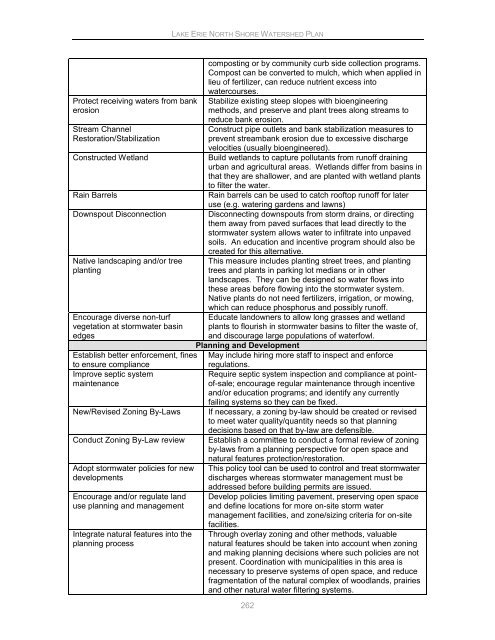Lake Erie North Shore Watershed Plan - Niagara Peninsula ...
Lake Erie North Shore Watershed Plan - Niagara Peninsula ...
Lake Erie North Shore Watershed Plan - Niagara Peninsula ...
Create successful ePaper yourself
Turn your PDF publications into a flip-book with our unique Google optimized e-Paper software.
LAKE ERIE NORTH SHORE WATERSHED PLAN<br />
Protect receiving waters from bank<br />
erosion<br />
Stream Channel<br />
Restoration/Stabilization<br />
Constructed Wetland<br />
Rain Barrels<br />
Downspout Disconnection<br />
Native landscaping and/or tree<br />
planting<br />
Encourage diverse non-turf<br />
vegetation at stormwater basin<br />
edges<br />
Establish better enforcement, fines<br />
to ensure compliance<br />
Improve septic system<br />
maintenance<br />
New/Revised Zoning By-Laws<br />
Conduct Zoning By-Law review<br />
Adopt stormwater policies for new<br />
developments<br />
Encourage and/or regulate land<br />
use planning and management<br />
Integrate natural features into the<br />
planning process<br />
composting or by community curb side collection programs.<br />
Compost can be converted to mulch, which when applied in<br />
lieu of fertilizer, can reduce nutrient excess into<br />
watercourses.<br />
Stabilize existing steep slopes with bioengineering<br />
methods, and preserve and plant trees along streams to<br />
reduce bank erosion.<br />
Construct pipe outlets and bank stabilization measures to<br />
prevent streambank erosion due to excessive discharge<br />
velocities (usually bioengineered).<br />
Build wetlands to capture pollutants from runoff draining<br />
urban and agricultural areas. Wetlands differ from basins in<br />
that they are shallower, and are planted with wetland plants<br />
to filter the water.<br />
Rain barrels can be used to catch rooftop runoff for later<br />
use (e.g. watering gardens and lawns)<br />
Disconnecting downspouts from storm drains, or directing<br />
them away from paved surfaces that lead directly to the<br />
stormwater system allows water to infiltrate into unpaved<br />
soils. An education and incentive program should also be<br />
created for this alternative.<br />
This measure includes planting street trees, and planting<br />
trees and plants in parking lot medians or in other<br />
landscapes. They can be designed so water flows into<br />
these areas before flowing into the stormwater system.<br />
Native plants do not need fertilizers, irrigation, or mowing,<br />
which can reduce phosphorus and possibly runoff.<br />
Educate landowners to allow long grasses and wetland<br />
plants to flourish in stormwater basins to filter the waste of,<br />
and discourage large populations of waterfowl.<br />
<strong>Plan</strong>ning and Development<br />
May include hiring more staff to inspect and enforce<br />
regulations.<br />
Require septic system inspection and compliance at pointof-sale;<br />
encourage regular maintenance through incentive<br />
and/or education programs; and identify any currently<br />
failing systems so they can be fixed.<br />
If necessary, a zoning by-law should be created or revised<br />
to meet water quality/quantity needs so that planning<br />
decisions based on that by-law are defensible.<br />
Establish a committee to conduct a formal review of zoning<br />
by-laws from a planning perspective for open space and<br />
natural features protection/restoration.<br />
This policy tool can be used to control and treat stormwater<br />
discharges whereas stormwater management must be<br />
addressed before building permits are issued.<br />
Develop policies limiting pavement, preserving open space<br />
and define locations for more on-site storm water<br />
management facilities, and zone/sizing criteria for on-site<br />
facilities.<br />
Through overlay zoning and other methods, valuable<br />
natural features should be taken into account when zoning<br />
and making planning decisions where such policies are not<br />
present. Coordination with municipalities in this area is<br />
necessary to preserve systems of open space, and reduce<br />
fragmentation of the natural complex of woodlands, prairies<br />
and other natural water filtering systems.<br />
262
















